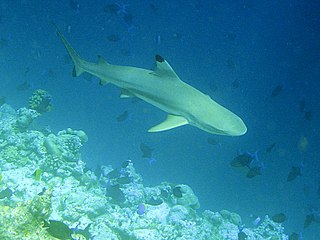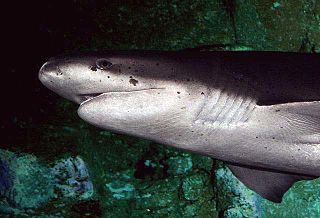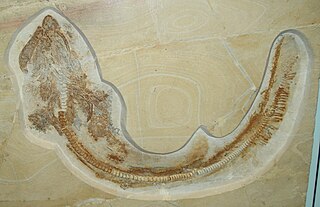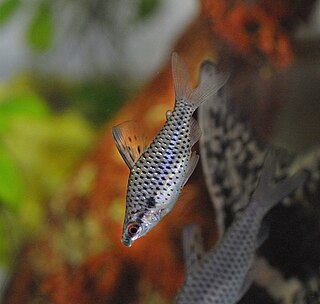Related Research Articles

Myliobatiformes is one of the four orders of batoids, cartilaginous fishes related to sharks. They were formerly included in the order Rajiformes, but more recent phylogenetic studies have shown the myliobatiforms to be a monophyletic group, and its more derived members evolved their highly flattened shapes independently of the skates.

Requiem sharks are sharks of the family Carcharhinidae in the order Carcharhiniformes. They are migratory, live-bearing sharks of warm seas and include such species as the bull shark, lemon shark, blacktip shark, and whitetip reef shark.

The Hexanchiformes are a primitive order of sharks, numbering just seven extant species in two families. Fossil sharks that were apparently very similar to modern sevengill species are known from Jurassic specimens.

The Lamniformes are an order of sharks commonly known as mackerel sharks. It includes some of the most familiar species of sharks, such as the great white as well as less familiar ones, such as the goblin shark and megamouth shark.

A headstander is any of several species of South American fish, including Anostomus ternetzi, Anostomus anostomus and members of genus Chilodus from the family Chilodontidae. The name derives from their habit of swimming at a 45° angle, head pointed downwards, as if "standing on their heads".

Rajiformes is one of the four orders in the clade Batomorphi, often referred to as the superorder Batoidea, flattened cartilaginous fishes related to sharks. Rajiforms are distinguished by the presence of greatly enlarged pectoral fins, which reach as far forward as the sides of the head, with a generally flattened body. The undulatory pectoral fin motion diagnostic to this taxon is known as rajiform locomotion. The eyes and spiracles are located on the upper surface of the head and the gill slits are on the underside of the body. Most species give birth to live young, although some lay eggs enclosed in a horny capsule.

Xenacanthida is an order or superorder of extinct shark-like chondrichthyans known from the Carboniferous to Triassic. They were native to freshwater, marginal marine and shallow marine habitats. Some xenacanths may have grown to lengths of 5 m (16 ft). Most xenacanths died out at the end of the Permian in the End-Permian Mass Extinction, with only a few forms surviving into the Triassic.

Hybodus is an extinct genus of hybodont that lived from the Middle Triassic to the Late Cretaceous periods. Species closely related to the type species Hybodus reticulatus lived during the Early Jurassic epoch. Numerous species have been assigned to Hybodus spanning a large period of time, and it is currently considered a wastebasket taxon that is 'broadly polyphyletic' and requires reexamination.

Myliobatis is a genus of eagle rays in the family Myliobatidae.

Himantura is a genus of stingray in the family Dasyatidae that is native to the Indo-Pacific. In a 2016 taxonomic revision, many of the species formerly assigned to Himantura were reassigned to other genera.

Hybodontiformes, commonly called hybodonts, are an extinct group of shark-like cartilaginous fish (chondrichthyans) which existed from the late Devonian to the Late Cretaceous. Hybodonts share a close common ancestry with modern sharks and rays (Neoselachii) as part of the clade Euselachii. They are distinguished from other chondrichthyans by their distinctive fin spines and cephalic spines present on the heads of males. An ecologically diverse group, they were abundant in marine and freshwater environments during the late Paleozoic and early Mesozoic, but were rare in open marine environments by the end of the Jurassic, having been largely replaced by modern sharks, though they were still common in freshwater and marginal marine habitats. They survived until the end of the Cretaceous, before going extinct.

Arhynchobatidae is a family of skates whose members are commonly known as the softnose skates. It belongs to the order Rajiformes in the superorder Batoidea of rays. At least 104 species have been described, in 13 genera. Softnose skates have at times been placed in the same family as hardnose skates, but most recent authors recognize them as a distinct family. Members of the Arhynchobatidae can be distinguished from hardnose skates in having a soft and flexible snout, as well as a more or less reduced rostrum.

Paraorthacodus is an extinct genus of shark. It a member of the family Paraorthacodontidae, which is either placed in Hexanchiformes or in Synechodontiformes. It is known from over a dozen named species spanning from the Early Jurassic to the Paleocene, or possibly Eocene. Almost all members of the genus are exclusively known from isolated teeth, with the exception of P. jurensis from the Late Jurassic-Early Cretaceous of Europe, which is known from full body fossils from the Late Jurassic of Germany, which suggest that juveniles had a robust body with a round head, while adults had large body sizes with a fusiform profile. There was only a single dorsal fin towards the back of the body without a fin spine. The dentition had teeth with a single large central cusp along with shorter lateral cusplets, which were designed for clutching. The teeth are distinguished from those of Synechodus by the lateral cusplets decreasing in size linearly away from the central cusp rather than exponentially as in Synechodus.

Batomorphi is a clade of cartilaginous fishes, commonly known as rays, this taxon is also known as the superorder Batoidea, but the 5th edition of Fishes of the World classifies it as the division Batomorphi. They and their close relatives, the sharks, compose the subclass Elasmobranchii. Rays are the largest group of cartilaginous fishes, with well over 600 species in 26 families. Rays are distinguished by their flattened bodies, enlarged pectoral fins that are fused to the head, and gill slits that are placed on their ventral surfaces.

Chilodus is a genus of extant chilodontid (characiform) headstanders from South America They live in the Orinoco and Amazon Basins, as well as in various rivers in the Guianas. The currently described, valid species in this genus are:

Pseudocorax is an extinct genus of mackerel sharks that lived during the Late Cretaceous. It contains six valid species that have been found in Europe, the Middle East, North Africa, and North America. It was formerly assigned to the family Anacoracidae, but is now placed in its own family Pseudocoracidae along with Galeocorax. The former species "P." australis and "P." primulus have been reidentified as species of Echinorhinus and Squalicorax, respectively.

Rhinopristiformes is an order of rays, cartilaginous fishes related to sharks, containing shovelnose rays and allied groups.

Synechodontiformes is an extinct order of prehistoric shark-like cartilaginous fish, known from the Permian to the Paleogene. They are considered to be members of Neoselachii, the group that contains modern sharks and rays.

Paracestracion is an extinct genus of heterodontiform sharks from Early Jurassic to Early Cretaceous-aged rocks of England, France, Germany and Luxembourg. The genus was first described in 1911 by Ernst Hermann Friedrich von Koken in Karl Alfred von Zittel.

Anotodus is an extinct genus of thresher sharks that lived during the Neogene. It contains one valid species, Anotodus retroflexus, which has been found in North America, South America, Europe, and Australia.
References
- 1 2 3 4 Greenfield, T. (2024). "Arthrobatidae nom. nov., a replacement for the invalid name Arthropteridae Jordan, 1905 (?Chondrichthyes, ?Batomorphii)". Zootaxa. 5433 (2): 299–300. doi:10.11646/zootaxa.5433.2.9. PMID 39645750.
- 1 2 3 Whitley, G.P. (1940). "The Nomenclator Zoologicus and some new fish names". The Australian Naturalist. 10 (7): 241–243.
- 1 2 3 Agassiz, J.L.R. (1837–1843). Recherches sur les poissons fossiles. Tome III. Neuchâtel, CH & Soleure, CH: Petitpierre & Jent et Gassmann. p. 379. doi: 10.5962/bhl.title.4275 .
- 1 2 Jordan, D.S. (1905). A Guide to the Study of Fishes. Vol I. New York, NY: Henry Holt and Company. p. 553. doi: 10.5962/bhl.title.57157 .
- 1 2 Macleay, W.S. (1838). Illustrations of the Annulosa of South Africa; Being a Portion of the Objects of Natural History Chiefly Collected During an Expedition into the Interior of South Africa, Under the Direction of Dr. Andrew Smith, in the Years 1834, 1835, and 1836; Fitted Out by "The Cape of Good Hope Association for Exploring Central Africa". London, UK: Smith, Elder and Co. p. 75. doi: 10.5962/bhl.title.10416 .
- 1 2 Giebel, C.G.A. (1848). Fauna der Vorwelt mit steter Berücksichtigung der lebenden Thiere. Erster Band: Wirbelthiere. Dritte Abtheilung: Fische. Leipzig, DE: F.A. Brockhaus. pp. 295 431. doi: 10.5962/bhl.title.24938 .
- ↑ Bleeker, P. (1859). "Enumeratio specierum piscium hucusque in Archipelago Indico observatorum, adjectis habitationibus citationibusque, ubi descriptiones earum recentiores reperiuntur, nec non speciebus Musei Bleekeriani Bengalensibus, Japonicis, Capensibus Tasmanicisque". Acta Societatis Scientiarum Indo-Neêrlandicae. 6 (3): i–xxxvi, 1–276.
- ↑ Günther, A.C.L.G. (1880). An Introduction to the Study of Fishes. Edinburgh, UK: Adam and Charles Black. p. 342. doi: 10.5962/bhl.title.16294 .
- ↑ Cappetta, H. (1987). Handbook of Paleoichthyology. Volume 3B. Chondrichthyes II. Mesozoic and Cenozoic Elasmobranchii. Stuttgart, DE: Gustav Fischer Verlag. p. 135.
- ↑ Stumpf, S.; Kriwet, J. (2019). "A new Pliensbachian elasmobranch (Vertebrata, Chondrichthyes) assemblage from Europe, and its contribution to the understanding of late Early Jurassic elasmobranch diversity and distributional patterns". PalZ. 93 (4): 637–658. Bibcode:2019PalZ...93..637S. doi: 10.1007/s12542-019-00451-4 . ISSN 1867-6812.